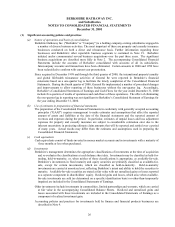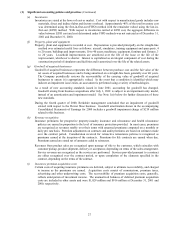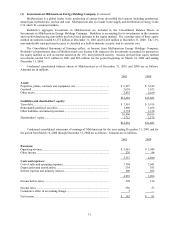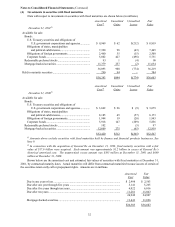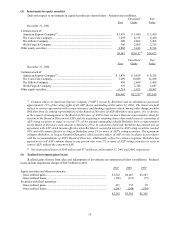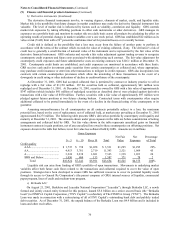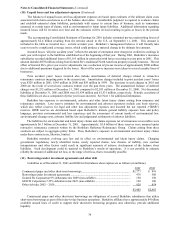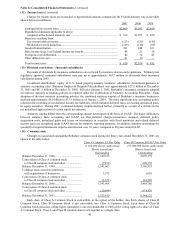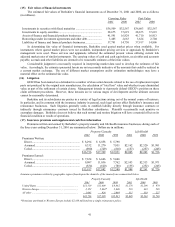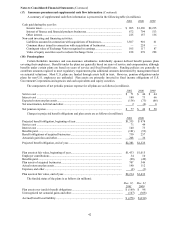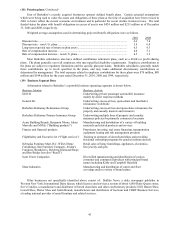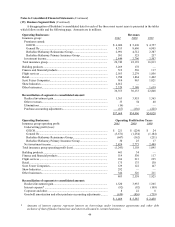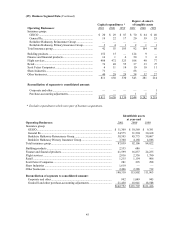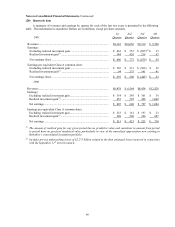Berkshire Hathaway 2001 Annual Report Download - page 37
Download and view the complete annual report
Please find page 37 of the 2001 Berkshire Hathaway annual report below. You can navigate through the pages in the report by either clicking on the pages listed below, or by using the keyword search tool below to find specific information within the annual report.
36
Notes to Consolidated Financial Statements (Continued)
(9) Finance and financial products businesses (Continued)
b) Derivative instruments (Continued)
The derivative financial instruments involve, to varying degrees, elements of market, credit, and liquidity risks.
Market risk is the possibility that future changes in market conditions may make the derivative financial instrument less
valuable. The level of market risk is influenced by factors such as volatility, correlation and liquidity. GRS controls
market risk exposures by taking offsetting positions in either cash instruments or other derivatives. GRS manages its
exposures on a portfolio basis and monitors its market risk on a daily basis across all products by calculating the effect on
operating results of potential changes in market variables over a one week period. GRS has established $22 million as its
value at risk (VAR) limit with a 99th percentile confidence interval for potential losses over a weekly horizon.
Credit risk is defined as the possibility that a loss may occur from the failure of another party to perform in
accordance with the terms of the contract which exceeds the value of existing collateral, if any. The derivative’ s risk of
credit loss is generally a small fraction of notional value of the instrument and is represented by the fair value of the
derivative financial instrument. GRS evaluates and records a fair value adjustment against trading revenue to recognize
counterparty credit exposure and future costs associated with administering each contract. The fair value adjustment for
counterparty credit exposures and future administrative costs on existing contracts was $126.1 million at December 31,
2001. Counterparty credit limits are established, and credit exposures are monitored in accordance with these limits.
GRS receives cash and/or investment grade securities from certain counterparties as collateral and, where appropriate,
may purchase credit insurance or enter into other transactions to mitigate its credit exposure. GRS also incorporates into
contracts with certain counterparties provisions which allow the unwinding of these transactions in the event of a
downgrade in credit rating or other indications of decline in creditworthiness of the counterparty.
At December 31, 2001, GRS had accepted collateral that is permitted by contract or industry practice to sell or
repledge with a fair value of $1,150 million. Of the securities held as collateral, approximately $41 million were
repledged as of December 31, 2001. At December 31, 2001, securities owned by GRS with a fair value of approximately
$347 million (which includes $41 million of repledged securities as described above) were pledged against derivative
transactions with a fair value of $550 million. Further, securities with a fair value of approximately $97 million were
pledged against futures positions at two futures clearing brokers. Contractual terms with counterparties often require
additional collateral to be posted immediately in the event of a decline in the financial rating of the counterparty or its
guarantor.
Assuming non-performance by all counterparties on all contracts potentially subject to a loss, the maximum
potential loss, based on the cost of replacement, net of collateral held, at market rates prevailing at December 31, 2001
approximated $4,375 million. The following table presents GRS’ s derivatives portfolio by counterparty credit quality and
maturity at December 31, 2001. The amounts shown under gross exposure in the table are before consideration of netting
arrangements and collateral held by GRS. Net fair value shown in the table represents unrealized gains on financial
instrument contracts in gain positions, net of any unrealized loss owed to these counterparties on offsetting positions. Net
exposure shown in the table that follows is net fair value less collateral held by GRS. Amounts are in millions.
Gross Exposure
Net Fair Net Percentage
0 – 5 6 – 10 Over 10 Total Value Exposure of Total
Credit quality
AAA ....................................... $ 1,735 $ 738 $1,058 $ 3,531 $1,295 $1,295 29%
AA.......................................... 4,913 3,761 2,719 11,393 2,521 1,969 45
A............................................. 3,224 2,238 1,681 7,143 1,338 1,033 24
BBB and Below...................... 1,050 404 133 1,587 371 78 2
Total $10,922 $7,141 $5,591 $23,654 $5,525 $4,375 100%
Liquidity risk can arise from funding of GRS’ s portfolio of open transactions. Movements in underlying market
variables affect both future cash flows related to the transactions and collateral required to cover the value of open
positions. Strategies have been developed to ensure GRS has sufficient resources to cover its potential liquidity needs
through its access to General Re Corporation’ s (the parent company of GRS) internal sources of liquidity, commercial
paper program, lines of credit and medium-term program.
c) Berkadia LLC
On August 21, 2001, Berkshire and Leucadia National Corporation (“Leucadia”), through Berkadia LLC, a newly
formed and jointly owned entity formed for this purpose, loaned $5.6 billion on a senior secured basis (the “Berkadia
Loan”) to FINOVA Capital Corporation, (“FNV Capital”) a subsidiary of The FINOVA Group (“FNV”). The Berkadia
Loan was made in connection with a restructuring of all of FNV Capital’ s outstanding bank debt and publicly traded
debt securities. As of December 31, 2001, the unpaid balance of the Berkadia Loan was $4.9 billion and is included in
loans and other receivables.


